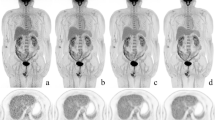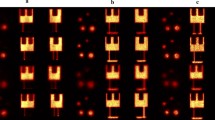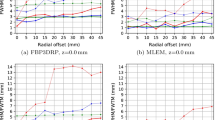Abstract
Purpose
The objective of the study was to evaluate state-of-the-art clinical PET/CT technology in performing static and dynamic imaging of several mice simultaneously.
Methods
A mouse-sized phantom was imaged mimicking simultaneous imaging of three mice with computation of recovery coefficients (RCs) and spillover ratios (SORs). Fifteen mice harbouring abdominal or subcutaneous tumours were imaged on clinical PET/CT with point spread function (PSF) reconstruction after injection of [18F]fluorodeoxyglucose or [18F]fluorothymidine. Three of these mice were imaged alone and simultaneously at radial positions –5, 0 and 5 cm. The remaining 12 tumour-bearing mice were imaged in groups of 3 to establish the quantitative accuracy of PET data using ex vivo gamma counting as the reference. Finally, a dynamic scan was performed in three mice simultaneously after the injection of 68Ga-ethylenediaminetetraacetic acid (EDTA).
Results
For typical lesion sizes of 7–8 mm phantom experiments indicated RCs of 0.42 and 0.76 for ordered subsets expectation maximization (OSEM) and PSF reconstruction, respectively. For PSF reconstruction, SORair and SORwater were 5.3 and 7.5%, respectively. A strong correlation (r 2 = 0.97, p < 0.0001) between quantitative data obtained in mice imaged alone and simultaneously in a group of three was found following PSF reconstruction. The correlation between ex vivo counting and PET/CT data was better with PSF reconstruction (r 2 = 0.98; slope = 0.89, p < 0.0001) than without (r 2 = 0.96; slope = 0.62, p < 0.001). Valid time-activity curves of the blood pool, kidneys and bladder could be derived from 68Ga-EDTA dynamic acquisition.
Conclusion
New generation clinical PET/CT can be used for simultaneous imaging of multiple small animals in experiments requiring high throughput and where a dedicated small animal PET system is not available.






Similar content being viewed by others
References
Nanni C, Di Leo K, Tonelli R, Pettinato C, Rubello D, Spinelli A, et al. FDG small animal PET permits early detection of malignant cells in a xenograft murine model. Eur J Nucl Med Mol Imaging 2007;34:755–62.
Aide N, Poulain L, Briand M, Dutoit S, Allouche S, Labiche A, et al. Early evaluation of the effects of chemotherapy with longitudinal FDG small-animal PET in human testicular cancer xenografts: early flare response does not reflect refractory disease. Eur J Nucl Med Mol Imaging 2009;36:396–405.
Dorow DS, Cullinane C, Conus N, Roselt P, Binns D, McCarthy TJ, et al. Multi-tracer small animal PET imaging of the tumour response to the novel pan-Erb-B inhibitor CI-1033. Eur J Nucl Med Mol Imaging 2006;33:441–52.
Wolf G, Abolmaali N. Imaging tumour-bearing animals using clinical scanners. Int J Radiat Biol 2009;85:752–62.
Panin VY, Kehren F, Michel C, Casey M. Fully 3-D PET reconstruction with system matrix derived from point source measurements. IEEE Trans Med Imaging 2006;25:907–21.
Pichler BJ, Wehrl HF, Judenhofer MS. Latest advances in molecular imaging instrumentation. J Nucl Med 2008;49(Suppl 2):5S–23S.
Townsend DW. Dual-modality imaging: combining anatomy and function. J Nucl Med 2008;49:938–55.
Huisman MC, Reder S, Weber AW, Ziegler SI, Schwaiger M. Performance evaluation of the Philips MOSAIC small animal PET scanner. Eur J Nucl Med Mol Imaging 2007;34:532–40.
Tatsumi M, Nakamoto Y, Traughber B, Marshall LT, Geschwind JF, Wahl RL. Initial experience in small animal tumor imaging with a clinical positron emission tomography/computed tomography scanner using 2-[F-18]fluoro-2-deoxy-D-glucose. Cancer Res 2003;63:6252–7.
Visser EP, Van Dalen JA, Laverman P, Newport D, Corstens FHM, Oyen WJG, et al. Evaluation of attenuation correction in the Inveon preclinical PET scanner using two opposite, rotating 57-Co sources. Eur J Nucl Med Mol Imaging 2007;34:S227.
Machulla HJ, Blocher A, Kuntzsch M, Piert M, Wei R, Grierson JR. Simplified labeling approach for synthesizing 3′-deoxy-3′-[18F]fluorothymidine ([18F]FLT). J Radioanal Nucl Chem 2000;243:843–46.
Zhernosekov KP, Filosofov DV, Baum RP, Aschoff P, Bihl H, Razbash AA, et al. Processing of generator-produced 68Ga for medical application. J Nucl Med 2007;48:1741–8.
Brambilla M, Secco C, Dominietto M, Matheoud R, Sachetti G, Inglese E. Performance characteristics obtained for a new 3-dimensional lutetium oxyorthosilicate-based whole-body PET/CT scanner with the National Electrical Manufacturers Association NU 2–2001 standard. J Nucl Med 2005;46:2083–91.
Daube-Witherspoon ME, Karp JS, Casey ME, DiFillipo FP, Hines H, Muehllehner G, et al. PET performance measurements using the NEMA NU-2001 standard. J Nucl Med 2002;43:1398–409.
Watson CC. New, faster, image-based scatter correction for 3-D PET. IEEE Trans Nucl Sci 2000;47:1587–94.
Kinahan PE, Hasegawa BH, Beyer T. X-ray-based attenuation correction for positron emission tomography/computed tomography scanners. Semin Nucl Med 2003;33:166–79.
Dinulescu DM, Ince TA, Quade BJ, Shafer SA, Crowley D, Jacks T. Role of K-ras and Pten in the development of mouse models of endometriosis and endometrioid ovarian cancer. Nat Med 2005;11:63–70.
Hoffman EJ, Huang SC, Phelps ME. Quantitation in positron emission computed tomography: 1. Effect of object size. J Comput Assist Tomogr 1979;3:299–308.
Soret M, Bacharach SL, Buvat I. Partial-volume effect in PET tumor imaging. J Nucl Med 2007;48:932–45.
Aide N, Louis MH, Dutoit S, Labiche A, Lemoisson E, Briand M, et al. Improvement of semi-quantitative small-animal PET data with recovery coefficients: a phantom and rat study. Nucl Med Commun 2007;28:813–22.
Bland JM, Altman DG. Statistical methods for assessing agreement between two methods of clinical measurement. Lancet 1986;1:307–10.
Hilson A. Bland-Altman plot. Radiology 2004;231:604. author reply 604–5.
Dandekar M, Tseng JR, Gambhir SS. Reproducibility of 18F-FDG microPET studies in mouse tumor xenografts. J Nucl Med 2007;48:602–7.
Nagengast WB, de Vries EG, Hospers GA, Mulder NH, de Jong JR, Hollema H, et al. In vivo VEGF imaging with radiolabeled bevacizumab in a human ovarian tumor xenograft. J Nucl Med 2007;48:1313–9.
Brix G, Doll J, Belleman ME, Trojan H, Haberkorn U, Schmidlin P, et al. Use of scanner characteristics in iterative image reconstruction for high-resolution positron emission tomography studies of small animals. Eur J Nucl Med 1997;24:779–86.
Seemann MD, Beck R, Ziegler S. In vivo tumor imaging using a state-of-the-art clinical PET/CT in comparison with a small animal PET and a small animal CT. Technol Cancer Res Treat 2006;5:537–42.
Aubry K, Shao Z, Monteil J, Paraf F, Bessède JP, Rigaud M. FDG-PET/CT of head and neck squamous cell carcinoma in a rat model. Mol Imaging Biol 2009;11:88–93.
Song SL, Liu JJ, Huang G, Wang ZH, Song YY, Sun XG, et al. Changes in 18F-FDG uptake within minutes after chemotherapy in a rabbit VX2 tumor model. J Nucl Med 2008;49:303–9.
Willekens I, Lahoutte T, Buls N, Vanhove C, Deklerck R, Bossuyt A, et al. Time-course of contrast enhancement in spleen and liver with Exia 160, Fenestra LC, and VC. Mol Imaging Biol 2009;11:128–35.
Aide N, Kinross K, Neels O, Roselt P, Hicks RJ. A dual contrast agent protocol improves 18F-FDG and 18F-FLT PET/CT imaging of mice bearing abdominal tumours. Eur J Nucl Med Mol Imaging 2009;36:S415.
Boone JM, Velazquez O, Cherry SR. Small-animal X-ray dose from micro-CT. Mol Imaging 2004;3:149–58.
Winkelmann CT, Figueroa SD, Rold TL, Volkert WA, Hoffman TJ. Microimaging characterization of a B16–F10 melanoma metastasis mouse model. Mol Imaging 2006;5:105–14.
Bao Q, Newport D, Chen M, Stout DB, Chatziioannou AF. Performance evaluation of the Inveon dedicated PET preclinical tomograph based on the NEMA NU-4 standards. J Nucl Med 2009;50:401–8.
Constantinescu CC, Mukherjee J. Performance evaluation of an Inveon PET preclinical scanner. Phys Med Biol 2009;54:2885–99.
Visser EP, Disselhorst JA, Brom M, Laverman P, Gotthardt M, Oyen WJ, et al. Spatial resolution and sensitivity of the Inveon small-animal PET scanner. J Nucl Med 2009;50:139–47.
Wang Y, Seidel J, Tsui BM, Vaquero JJ, Pomper MG. Performance evaluation of the GE Healthcare eXplore VISTA dual-ring small-animal PET scanner. J Nucl Med 2006;47:1891–900.
Qi J, Leahy RM, Cherry SR, Chatziioannou AF, Farquhar T. High-resolution 3D Bayesian image reconstruction using the microPET small-animal scanner. Phys Med Biol 1998;43:1001–13.
Sureau FC, Reader AJ, Comtat C, Leroy C, Ribeiro MJ, Buvat I, et al. Impact of image-space resolution modeling for studies with the high-resolution research tomograph. J Nucl Med 2008;49:1000–8.
Varrone A, Sjöholm N, Eriksson L, Gulyás B, Halldin C, Farde L. Advancement in PET quantification using 3D-OP-OSEM point spread function reconstruction with the HRRT. Eur J Nucl Med Mol Imaging 2009;36:1639–50.
Cheng TE, Yoder KK, Normandin MD, Risacher SL, Converse AK, Hampel JA, et al. A rat head holder for simultaneous scanning of two rats in small animal PET scanners: design, construction, feasibility testing and kinetic validation. J Neurosci Methods 2009;176:24–33.
Acknowledgments
This work was supported by a grant from the French Ligue contre le cancer, comité du calvados and by a Fellowship from the Fondation de France.
The authors are indebted to Emily Hong, Jason Callahan, David Binns and Mark Scalzo for their help during animal PET acquisitions and ex vivo counting, and to the animal technologists and research assistants (Rachel Walker, Susan Jackson, Kerry Ardley, Jeannette Valentan, Ekaterina Bogatyreva and Laura Kirby) from the Centre for Molecular Imaging for animal care and tracer injections. Dr. Aide thanks Dr. Lerouge for her continuous support during this work.
Conflicts of interest
None.
Author information
Authors and Affiliations
Corresponding author
Rights and permissions
About this article
Cite this article
Aide, N., Desmonts, C., Beauregard, JM. et al. High throughput static and dynamic small animal imaging using clinical PET/CT: potential preclinical applications. Eur J Nucl Med Mol Imaging 37, 991–1001 (2010). https://doi.org/10.1007/s00259-009-1352-1
Received:
Accepted:
Published:
Issue Date:
DOI: https://doi.org/10.1007/s00259-009-1352-1




